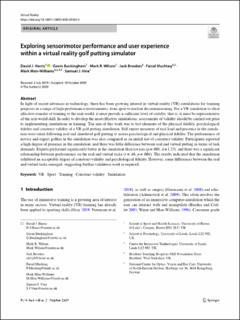| dc.contributor.author | Harris, David J. | |
| dc.contributor.author | Buckingham, Gavin | |
| dc.contributor.author | Wilson, Mark Robert | |
| dc.contributor.author | Brookes, Jack | |
| dc.contributor.author | Mushtaq, Faisal | |
| dc.contributor.author | Mon-Williams, Mark | |
| dc.contributor.author | Vine, Samuel J. | |
| dc.date.accessioned | 2021-03-24T14:57:29Z | |
| dc.date.available | 2021-03-24T14:57:29Z | |
| dc.date.created | 2020-10-30T10:47:14Z | |
| dc.date.issued | 2020 | |
| dc.identifier.citation | Harris, D. J., Buckingham, G., Wilson, M. R., Brookes, J., Mushtaq, F., Mon-Williams, M., & Vine, S. J. (2020). Exploring sensorimotor performance and user experience within a virtual reality golf putting simulator. Virtual Reality. | en_US |
| dc.identifier.issn | 1359-4338 | |
| dc.identifier.uri | https://hdl.handle.net/11250/2735349 | |
| dc.description.abstract | In light of recent advances in technology, there has been growing interest in virtual reality (VR) simulations for training purposes in a range of high-performance environments, from sport to nuclear decommissioning. For a VR simulation to elicit effective transfer of training to the real-world, it must provide a sufficient level of validity, that is, it must be representative of the real-world skill. In order to develop the most effective simulations, assessments of validity should be carried out prior to implementing simulations in training. The aim of this work was to test elements of the physical fidelity, psychological fidelity and construct validity of a VR golf putting simulation. Self-report measures of task load and presence in the simulation were taken following real and simulated golf putting to assess psychological and physical fidelity. The performance of novice and expert golfers in the simulation was also compared as an initial test of construct validity. Participants reported a high degree of presence in the simulation, and there was little difference between real and virtual putting in terms of task demands. Experts performed significantly better in the simulation than novices (p = .001, d = 1.23), and there was a significant relationship between performance on the real and virtual tasks (r = .46, p = .004). The results indicated that the simulation exhibited an acceptable degree of construct validity and psychological fidelity. However, some differences between the real and virtual tasks emerged, suggesting further validation work is required. | en_US |
| dc.language.iso | eng | en_US |
| dc.rights | Navngivelse 4.0 Internasjonal | * |
| dc.rights.uri | http://creativecommons.org/licenses/by/4.0/deed.no | * |
| dc.title | Exploring sensorimotor performance and user experience within a virtual reality golf putting simulator | en_US |
| dc.type | Peer reviewed | en_US |
| dc.type | Journal article | en_US |
| dc.description.version | publishedVersion | en_US |
| dc.rights.holder | © The Author(s). | en_US |
| dc.source.journal | Virtual Reality | en_US |
| dc.identifier.doi | https://doi.org/10.1007/s10055-020-00480-4 | |
| dc.identifier.cristin | 1843540 | |
| cristin.ispublished | true | |
| cristin.fulltext | original | |
| cristin.qualitycode | 1 | |

